Old image of St. Paraskeva discovered under newer layers of St. Michael the Archangel icon
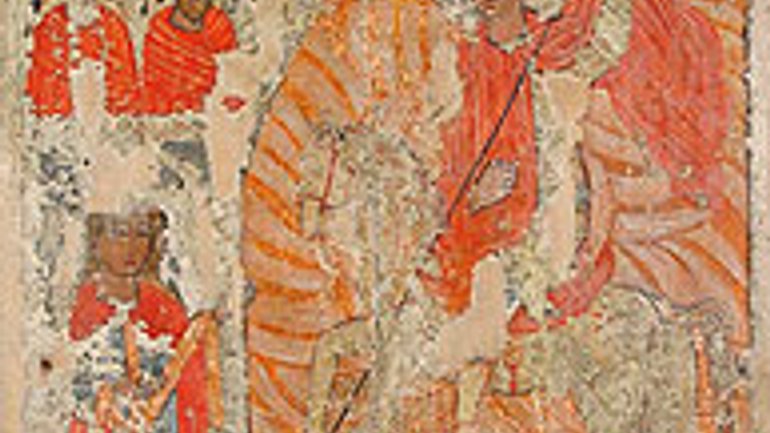
The uniqueness of the Volyn Icon Museum in northwestern Ukraine’s Volyn region can be discerned already from its name. The collection of the museum includes 1500 pieces of sacred art, with more than 600 icons of the Volyn school of the 16th through 18th centuries, as well as metal-plastics, decorative etching, and sculpture. The exhibit halls permanently exhibit 80 icons, a collection already restored. The rest of the icons are shown in occasional topical exhibitions due to lack of space. Exhibits currently on display include, for instance, “Volyn Etching, 16th-17th centuries” and “Engraving in Volyn Sacred Art,” where visitors can see covers of icons and Gospels of the 18th and early 19th centuries.
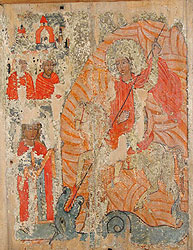 The exposition was arranged, following a topical and chronological principle, putting a stress on monastic iconographic workshops of the Kovel area, such as the Monastery of the Encounter (Presentation) in Mykhniv and St. Michael the Archangel Monastery in Bilostok (now Bialystok, Poland). Although the icons weren’t usually signed, some scholars classify a number of icons by their style as belonging to an anonymous author of 1630, or to his sphere of influence, thanks to a known and dated icon “The Life of St. George” of the same author. There are also works by Iov Kondzelevych, and Tomash and Stanislav Mychalskyi. Research done by the National Research and Restoration Center and the Moscow Institute of Traditional Technology mark some notable technical and technological characteristics of Volyn iconography, such as painting technique, composition of the levkas (gesso) and the frontal painting. Moreover chalk-glue bases with no addition of plaster were used, along with glue of animal origin, chalk extracted from the Volodymyr-Volynskyi basin area, and finally mineral, rather than plant, pigments. The images are lyrical and monumental in character, one finds laconic expression and traditional iconography, using certain colors in certain areas. Thus, icons from the area connected with the anonymous 1630 painter demonstrate a rather limited palette of blue, white, grey and ochre and no bright colors. The icons also tend to use a graphic line, which delineates the silhouette and facial features, and can be found both in the 1630 group and with 18th-century artists.
The exposition was arranged, following a topical and chronological principle, putting a stress on monastic iconographic workshops of the Kovel area, such as the Monastery of the Encounter (Presentation) in Mykhniv and St. Michael the Archangel Monastery in Bilostok (now Bialystok, Poland). Although the icons weren’t usually signed, some scholars classify a number of icons by their style as belonging to an anonymous author of 1630, or to his sphere of influence, thanks to a known and dated icon “The Life of St. George” of the same author. There are also works by Iov Kondzelevych, and Tomash and Stanislav Mychalskyi. Research done by the National Research and Restoration Center and the Moscow Institute of Traditional Technology mark some notable technical and technological characteristics of Volyn iconography, such as painting technique, composition of the levkas (gesso) and the frontal painting. Moreover chalk-glue bases with no addition of plaster were used, along with glue of animal origin, chalk extracted from the Volodymyr-Volynskyi basin area, and finally mineral, rather than plant, pigments. The images are lyrical and monumental in character, one finds laconic expression and traditional iconography, using certain colors in certain areas. Thus, icons from the area connected with the anonymous 1630 painter demonstrate a rather limited palette of blue, white, grey and ochre and no bright colors. The icons also tend to use a graphic line, which delineates the silhouette and facial features, and can be found both in the 1630 group and with 18th-century artists.
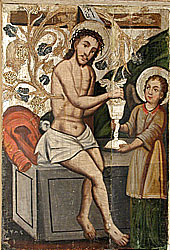 Archive sources mention guild-based painting in Ratne, Volodymyr-Volynskyi, Kovel and Lutsk. A list of painters from the first half of the 17th seventeenth century includes 72 names of iconographers, which proves that a broad network of commissions from monasteries and churches existed. Some of the most popular saints to be depicted on Volyn icons were: St. George the Conqueror, the Mother of God Hodigitria (she who shows the way), Christ the Pantocrator (ruler of all), St. Nicholas, St. Barbara (her cult was inspired by Duke Radziwill, who in 1654 brought her relics to the territory), St. Paraskeva, and the Archangel Michael surrounded by “Acts” and “Lives of the Saints.” Some interesting topics such as Christ the Grapevine, Christ in the Chalice, or Christ the Sleepless Eye are occasionally found. Many icons depict architectural ensembles, which enables the viewer to see architectural designs of past centuries.
Archive sources mention guild-based painting in Ratne, Volodymyr-Volynskyi, Kovel and Lutsk. A list of painters from the first half of the 17th seventeenth century includes 72 names of iconographers, which proves that a broad network of commissions from monasteries and churches existed. Some of the most popular saints to be depicted on Volyn icons were: St. George the Conqueror, the Mother of God Hodigitria (she who shows the way), Christ the Pantocrator (ruler of all), St. Nicholas, St. Barbara (her cult was inspired by Duke Radziwill, who in 1654 brought her relics to the territory), St. Paraskeva, and the Archangel Michael surrounded by “Acts” and “Lives of the Saints.” Some interesting topics such as Christ the Grapevine, Christ in the Chalice, or Christ the Sleepless Eye are occasionally found. Many icons depict architectural ensembles, which enables the viewer to see architectural designs of past centuries.
Eleven icons of the Volyn tempera tradition, and later periods of Roman Catholic church decoration (18th and 19th centuries) returned from restoration at the Ukrainian Academy of Arts last year. According to Tetiana Yeliseyeva, director of the museum, canvas art from Roman Catholic churches, as well as icons from Ukrainian Greek Catholic churches (the Orthodox Eparchy in Volyn ceased to exist in 1617), represent the most interesting material in recent research and form the basis for future expositions of oil paintings.
The idea of holding pieces of sacred art constantly on display emerged during archaeological expeditions of 1981 – 1985 which included members of the museum and were led by Pavlo Zholtovskyi, following a request by the Ministry of Culture to explore worship buildings of the region and register pieces of art. These expeditions were basically undertaken to save art: two-thirds of churches were closed at the time, their icons covered with mold, with gesso deteriorating, and entire parts disappearing. Part of the cult objects were added to the funds of ethnographic museums of Volyn and Rivne, the neighboring region, and those that were in urgent need of restoration were sent to research workshops of the Ukrainian Academy of Arts. The 26 rescued icons were first publicly displayed in an exposition entitled “The Cult of the Saints in the Orthodox Church” in the early 1990s. A later exposition, “Volyn Iconography of the 16th through 18th Centuries,” along with articles by a prominent Lviv-based researcher, Oleh Sydor, on the Volyn Painting School, became a starting point for arguing in support of a separate museum. The largest collection of Volyn icons in Ukraine provided the opportunity of showing stages of development of the local iconographic tradition. Unfortunately, examples of ancient iconography of the period of medieval princes went to other museums, thus the Volyn Mother of God from the 12th-13th centuries is still at the National Arts Museum, and the Mother of God of Drahomyr from the early 13th century is at the Rivne ethnographic museum. Still, most icons from the defining period of the 16th to eighteenth centuries remained here.
In the early 1990s, the Volyn Ethnographic Museum Department of Religion, whose employees collected sacred objects, was based in the non-active Church of Sts. Peter and Paul. When the former Museum of Atheism was given over to the Roman Catholic community, the issue of moving its rich collection arose. Rather unexpectedly, the Volyn Region Branch of the Security Service of Ukraine granted their premises for rent. The ethnographers renovated the building, prepared storerooms, and finally opened the new Volyn Icon Museum in 1993. However, when icons were moved from the church, it transpired that a restoration workshop needed to be created immediately, because a collection of this size could not be moved in one day. Professionals from the Lviv Department of the Kyiv Restoration Center and students of the Ukrainian Academy of Arts were incorporated into the preparation process. “We are very grateful,” said Tetiana Yeliseyeva, “to Fr. Ludwig Kamilewski, then-pastor of the Roman Catholic community, for not ousting us for an entire year, and keeping the icons in the church.” Meanwhile, problems arose with the security service: after two years, for no apparent reason, our landlords asked the museum to leave. There were attempts to resolve the scandal by addressing letters to the Ministry of Culture and a special Committee of the Ukrainian Parliament. Finally, the museum community was given a two-storey building downtown, which, to the joy of the tired scholars, was rebuilt with consideration for special conditions the museum needed, such as autonomous heating, air conditioning, fire and burglar alarms, a modern and properly-equipped restoration workshop and proper storerooms. The first visitors of 2001 had the opportunity to see the restored and never-before shown icons “The Savior in Glory,” from the first half of the 16th century (restored by Anatolii Kvasiuk), “Deisis,” from the first half of the 17th century, and “The Life of St. John the Apostle,” from the 18th century.
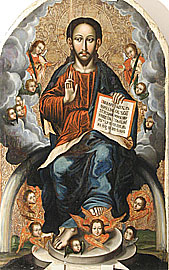 In addition to the already-mentioned Anatolii Kvasiuk, leader of the workshop, Lesia Obukhovych and Ukraine’s leading specialists, Pavlo Petrushak and Anastasia Chaban, are working on the restoration of the Volyn icons. Some of the restoration work on old icons is undertaken in the churches themselves. Thus, last year, Petrushak and Chaban completed the restoration of an icon of the Mother of God Hodigitria at the St. Elias Church in Kamen-Kashyrskyi. The icon had been repainted in the 18th century and her robe was characteristic of the Uniate period. When, upon agreement with the priest and community, the restorers removed the newer paint, a beautiful example of early-16th century monumental Volyn iconography (1.7 by 2 meters) was revealed. New discoveries are expected from future work on another icon, Christ the Pantocrator, from the same church. It is no longer surprising that a different subject might be hidden under re-paintings. The discovery of an icon of St. Paraskeva in the style of the 1630 painter under a late-18th century St. Michael the Archangel in arms was a memorable example. In the same way, a St. George icon by Iov Kondzelevych turned out to have been painted over an older icon of St. Basil. Now, therefore, the restorers, having learned not to trust what they see, make x-ray photographs of the icons at first, to find out whether older paintings could be hidden in them.
In addition to the already-mentioned Anatolii Kvasiuk, leader of the workshop, Lesia Obukhovych and Ukraine’s leading specialists, Pavlo Petrushak and Anastasia Chaban, are working on the restoration of the Volyn icons. Some of the restoration work on old icons is undertaken in the churches themselves. Thus, last year, Petrushak and Chaban completed the restoration of an icon of the Mother of God Hodigitria at the St. Elias Church in Kamen-Kashyrskyi. The icon had been repainted in the 18th century and her robe was characteristic of the Uniate period. When, upon agreement with the priest and community, the restorers removed the newer paint, a beautiful example of early-16th century monumental Volyn iconography (1.7 by 2 meters) was revealed. New discoveries are expected from future work on another icon, Christ the Pantocrator, from the same church. It is no longer surprising that a different subject might be hidden under re-paintings. The discovery of an icon of St. Paraskeva in the style of the 1630 painter under a late-18th century St. Michael the Archangel in arms was a memorable example. In the same way, a St. George icon by Iov Kondzelevych turned out to have been painted over an older icon of St. Basil. Now, therefore, the restorers, having learned not to trust what they see, make x-ray photographs of the icons at first, to find out whether older paintings could be hidden in them.
There are several resources for the museum to use to add new works to its stock. First of all, there are scholarly expeditions (22 in the period of 1997 through 2003). These expeditions research churches by authorization of eparchial authorities of the Ukrainian Orthodox churches of the Kyivan as well as Moscow patriarchates. It should be said that the museum has a full picture of what icons are kept in the churches, thanks to descriptions of the 1980s, and all valuable objects from that time on have been counted and registered, so any change can easily be discovered. Many of these icons are no longer used in religious services, and the communities painlessly give them over to the museum. In this way, a 16th-century icon of St. George, for instance, was found in the bell tower of the village of Holoby, Kovel district. This is the oldest depiction of the saint, whose cult spread throughout the region, because of Prince Volodymyr Vasylkovych, who had a Church of St. George built in Liuboml in the 13th century. The icon was restored by Iryna Melnyk, a Lviv-based professional. The money for the restoration was provided by Bishop Nyfont of the Ukrainian Orthodox Church – Moscow Patriarchate. Another dramatic instance took place in the village of Mateiky, Manevychi district, where old icons of the apostles were nailed to the wall in the attic. When the restorers started taking the icons down, wood crumbled. The scholars had doubts as to whether the icons could be saved. Only later did it turn out, to their relief, that the woodworm only destroyed the one, “plain” board that the icons were affixed to.
Sacred objects are added to museum not only as a result of expeditions or as gifts (like the icon of the Kholm Mother of God, donated by Nadia Horlytska, a well-known Volyn civic activist). Volyn customs have repeatedly given the museum icons taken from smugglers (usually examples of Russian iconography of the 18th and 19th centuries). A collection of 330 icons was put together as a result, and a “Resurrection to Ascension” exhibition was based on it. A collection of icons from Gospel covers was formed the same way. The icons feature interesting gold and silver incrustations in classical and rococo styles, and original subjects, such as “Weep Not for Me, O Mother,” “The Joy of All Afflicted,” “The Softening of Evil Hearts,” and “The Three Persons of God.” According to Tetiana Yeliseyeva, director of the museum, “these icons are not typical for Ukrainian iconography. They started appearing in Russia, in the late 18th and early 19th centuries, but after the Third Partition of Poland, when Volyn territories were included into the Russian Empire, these icons are found in our churches. It is difficult to establish whether religious objects taken at the border were bought or stolen. Experience tells us that icons in many churches are unfortunately not counted, registered and photographed, as is the practice in Poland.”
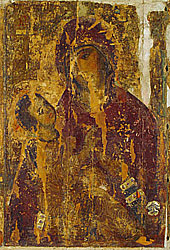 Obviously, in telling about the Volyn Icon Museum, it is impossible not to mention its pearl: the miraculous icon of the Kholm Mother of God, a unique instance of Byzantine iconography, dating back to the second half of the 12th century. The icon was taken off the exposition in early 2005, so that restorer Anatolii Kvasiuk could work on it “in peace.” Too often it had been exhibited in a separate hall for veneration, by requests from various delegations and churches. More than 3000 people came to see the icon in the past year. Tradition ascribes the authorship of the icon to St. Luke the Apostle. At one point there were four such icons in Ukraine: the Mother of God of Volodymyr-Vyshhorod, Mother of God of Belz (now in Czestochowa, Poland), The Dormition of the Mother of God (this icon succumbed to flames in the Kyivan Monastery of the Caves) and the Mother of God of Kholm, which was recently returned to Ukraine. The employees of the museum see this as a sign for the Ukrainian state, and a stimulus for their further scholarship and research, as well as educational work, exhibits and preservation of sacred objects.
Obviously, in telling about the Volyn Icon Museum, it is impossible not to mention its pearl: the miraculous icon of the Kholm Mother of God, a unique instance of Byzantine iconography, dating back to the second half of the 12th century. The icon was taken off the exposition in early 2005, so that restorer Anatolii Kvasiuk could work on it “in peace.” Too often it had been exhibited in a separate hall for veneration, by requests from various delegations and churches. More than 3000 people came to see the icon in the past year. Tradition ascribes the authorship of the icon to St. Luke the Apostle. At one point there were four such icons in Ukraine: the Mother of God of Volodymyr-Vyshhorod, Mother of God of Belz (now in Czestochowa, Poland), The Dormition of the Mother of God (this icon succumbed to flames in the Kyivan Monastery of the Caves) and the Mother of God of Kholm, which was recently returned to Ukraine. The employees of the museum see this as a sign for the Ukrainian state, and a stimulus for their further scholarship and research, as well as educational work, exhibits and preservation of sacred objects.
RISU’s Ukrainian-language site posted this article on 31 March 2005









